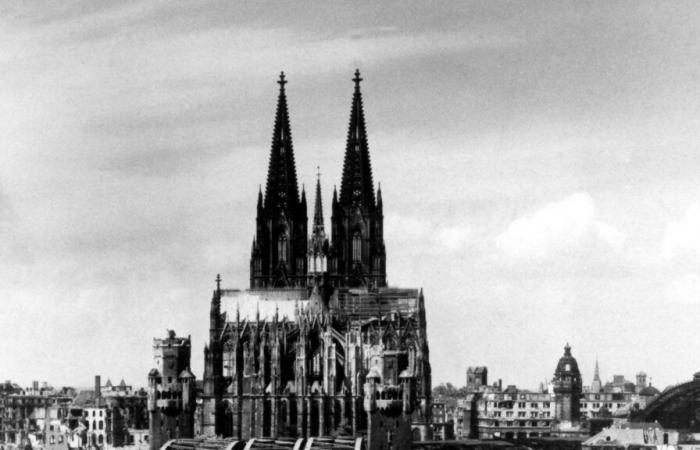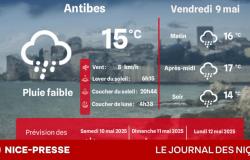The cities of rubble landscapes, which blown up Rheinbrücken, fled the population in air -raid shelves or to the country: On May 8, 80 years ago, the Second World War ended through the unconditional surrender of the German Reich. Since then, the day has been celebrated in many European countries as a day of liberation from National Socialism. The silence of the weapons went on Rhein and Ruhr dramatic weeks ahead.
While on the left bank of the Rhine like Cologne, the western Allies were already taken in March, Aachen even already in October 1944, it took significantly longer beyond the Rhine. On March 1, the Allied Mönchengladbach, on March 2, reached Neuss, Krefeld and the left bank of the Rhine Düsseldorf.
In Köln War rapporteurs and writers George Orwell were amazed at the Cologne team, who crawled from cellars and deep bunkers: «The propaganda, especially its own, made us believe that they all grown up, blond and arrogant. However, what you actually see in Cologne are more compact, dark -haired people (…). In any case, they are by no means particularly noticeable. »
The loop is drawn
The Allies could only cross the river in Wesel and almost 150 kilometers further south in Remagen because the bridges were still intact there. Then they quickly took the remnants of the Wehrmacht in the field of today’s North Rhine-Westphalia in the pliers and moved the loops further and further. On April 1, 1945, the so -called Ruhrkessel near Paderborn and Lippstadt closed. Hundreds of thousands of Wehrmacht soldiers sat in him in him.
The Ruhr area city of Essen, which Hitler and Mussolini proudly presented themselves with its Krupp factories in 1937 as the “Weapons forge of the Reich”, was particularly bombarded and around 90 percent destroyed. On March 11, 1945 alone, almost 1,100 bombs fell on food. A month later, Essen was taken on April 14th and Wuppertal, Mettmann and Solingen on April 16. On April 17, Allied tanks finally rolled through Düsseldorf.
While the Volkssturm of young people and old men had to oppose the Allies GestapoSS and NSDAP superiors before that many people no longer experienced the liberation.
At the end of January, the inspector of the security police, the former Düsseldorf Gestapo boss Walter Albath: For “special treatments”, the approval of the Reich Security Main Office was no longer necessary. “I now ask you to proceed everywhere.”
Mass shootings
In Remscheid, 71 prisoners were brought out of a prison, led to a gorge near Solingen and shot, reports historian Bastian Fleermann, who on the Rhine and Ruhr has reconstructed.
Forced laborers and prisoners of the Buchenwald concentration camp, who also had to clear the bomb rubble in Düsseldorf in Düsseldorf, were still arbitrarily killed in the past few days or sent to the so -called death marches. In Wuppertal and Dortmund, the Gestapo also carried out mass shootings, reports Fleermann.
In addition to Kripo, Gestapo and Wehrmacht, the notorious army ripening in the last weeks of the war murdered people. Some Düsseldorfers, who negotiated the city without a fight on their own on their own, were revealed and shot shortly before the city was liberated, the historian said.
“In the face of the military defeat, the responsible National Socialists have reinforced terror – as far as that was possible – again,” says historian Hans -Walter Hütter, President of the House of History NRW.
women open lock
In Lintorf north of Düsseldorf, which today belongs to Ratingen, it was after all women who opened the armored barriers at night and have white flags on the church towers, reports Fleermann.
The writer Emil Barth, who lived in Haan near Düsseldorf, noted in his diary: «The hour of fate, which we had all expected for months between fear and hope, came completely surprising yesterday morning. The fault shooting had stopped for three hours … »
But then the chaos suddenly broke out when Wehrmacht soldiers had run away from the approaching and shooting allies in a wild escape from the approaching and shooting allies and tried to get rid of their uniforms.
“The fight is over”
In the backyards and gardens, small fire blazed in which uniforms, Hitler pictures and party badges were burned. On April 19, the Wehrmacht High Command reported: The fight between the Ruhr and the Rhine has ended. Over 300,000 Wehrmacht soldiers went to American captivity.
Even Hitler’s most loyal accomplices such as Generalfeldmarschall Walter Model finally realized that the thousand -year -old empire hoped for by the Nazis was in the end after twelve years. Previously, Model had taken care of one of the last great slaughter of the Second World War in the Hürtgenwald and had soldiers shoot in rows in the Ruhr area as deserters.
He knew that he was sought by the Soviet Union as a war criminal for his leading role in the war of extermination in the east. When his officer staff in Ratingen near Düsseldorf was tracked down and captured by the Allies, Model had disappeared. On April 21, 1945, he shot himself in the forest between Lintorf and Duisburg.
Devastating destruction
«Cities like Düren, Jülich and Wesel were almost completely destroyed. We all talk about Dresden, but the degree of destruction there was significantly higher, »reports historian Hütter.
«The mood was ambivalent in the population after the ceasefire. Some found the end of the war to be defeat and still saw positive elements in the Hitler regime, even if you can hardly understand it today. The others hoped for peace and calm, »says Hütter. After that, the naked survival was in the foreground in the first post -war years.
© DPA-Infocom, DPA: 250508-930-514536/1








